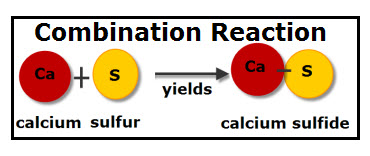Chemical Reaction
Subject: Science

Overview
Chemical equations describe the process of a chemical reaction, where reactants gain, lose, or share electrons to create products. These reactions can be categorized into three types: combination reactions, decomposition reactions, displacement reactions, and acid-base reactions. Combination reactions involve two or more reactants combining to create a single result. Decomposition reactions involve a reactant splitting into two or more products due to pressure, heat, or other factors. Displacement reactions involve replacing an atom or radical from one reactant with another, while acid-base reactions combine acids and bases to create salt and water.
Chemical Equation
An electron is either gained, lost, or shared by the reactants during a chemical reaction as they combine, disintegrate, or exchange ions to create products. A chemical reaction is a procedure that causes such a change. A chemical equation is a chemical reaction in which the reactants and products are expressed as words, symbols, or chemical formulas.
Types of Chemical Reaction
The types of reactants and products involved in chemical reactions can be classified into the following categories:
Combination Reaction
The chemical equation for the combination reaction is of the following type:
Combination reactions are those in which two or more reactants come together to generate a single result. Here are a few instances of combination reactions:
| 2Na Sodium |
+ | Cl2 Chlorine |
→ | 2 NaCl Sodium Chloride |
| C Carbon |
+ | O2 Oxygen |
→ | CO2 Carbon dioxide |
| N2 Nitrogen |
+ | 3H2 Hydrogen |
→ | 2NH3 Ammonia |
| 2Mg Magnesium |
+ | O2 Oxygen |
→ | 2MgO Magnesium Oxide |
| 4Fe Iron |
+ | 3O2 Oxygen |
→ | 2Fe2O3 Ferric Oxide |
Decomposition Reaction
The decomposition reaction's chemical equation is of the following kind:
A decomposition reaction is a chemical reaction in which a reactant splits into two or more products. Reactants break down as a result of pressure, heat, and other factors. For illustration, let's look at a few chemical reactions:
| CaCO3(s) | → | CaO (s) | + | CO2 (g) |
| 2NaOH(s) | → | Na2O (s) | + | H2O (l) |
| H2CO3(aq) | → | CO2 (g) | + | H2O (l) |
| 2KClO3(s) | → | 2KCl (s) | + | 3O2 (g) |
Displacement Reaction
A displacement reaction is a chemical reaction that happens when an atom or radical from one reactant replaces an atom or radical from another reactant. Two different kinds of displacement reactions exist.
- Single Displacement Reaction
One element or radical displaces another element or radical in a compound in a single displacement reaction.

Some examples of single displacement reactions are:Zn (s) + H2SO4 (aq) → ZnSO4 (aq) + H2(g) Zn (s) + 2HCL (aq) → ZnCl2 (aq) + H2 (g) Cu + 2AgNO3 → 2Ag + Cu (NO3)2 Ca + 2H2O → Ca(OH)2 + H2 Cl2 + 2NaBr → 2NaCl + H2 Br2 + 2Kl → 2KBr + l3
- Double Displacement Reaction
A double displacement reaction is a type of chemical reaction in which two reactants exchange atoms or radicals to generate two new molecules.
Some examples of double displacement reactions are:NaCl + AgNo → AgCl + NaNO BaCl2 + Na2SO4 → BaSO4 + 2NaCl Pb (NO3)2 + 2Kl → 2KNO3 + Pbl2
Acid-base Reaction
The term "acid-base reaction" refers to the process by which an acid and a base combine to generate salt and water. It's a kind of double displacement reaction as well. Both the acidic and basic characteristics are lost in the acid-base process, resulting in the formation of neutral substances. Thus, another name for it is a neutralization reaction.
Let's look at a few chemical reactions:
| HCl | + | NaOH | → | NaCl | + | H2O |
| H2SO4 | + | 2NaOH | → | Na2SO4 | + | H2O |
| KOH | + | HNO3 | → | KNO3 | + | H2O |
| CaO | + | 2HCl | → | CaCl2 | + | H2O |
Things to remember
- Chemical equations are used to describe the process of a chemical reaction, where reactants gain, lose, or share electrons to create products.
- Chemical reactions can be categorized into three types: combination reactions, decomposition reactions, displacement reactions, and acid-base reactions.
- Combination reactions involve two or more reactants combining to produce a single result.
- Decomposition reactions involve a reactant splitting into two or more products due to pressure, heat, or other factors.
- Displacement reactions involve replacing an atom or radical from one reactant with another. There are two types: single displacement reactions, where one element or radical displaces another in a compound, and double displacement reactions, where two reactants exchange atoms or radicals to generate two new molecules.
- Acid-base reactions, also known as neutralization reactions, involve the combination of an acid and a base to create salt and water, resulting in neutral substances.
© 2021 Saralmind. All Rights Reserved.


 Login with google
Login with google